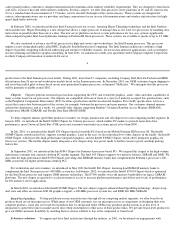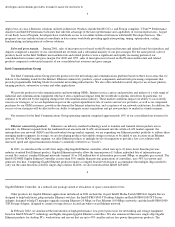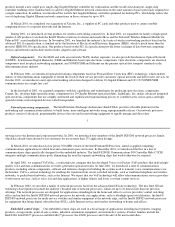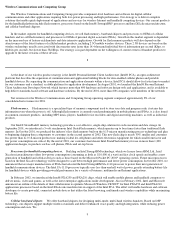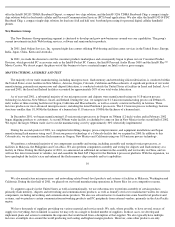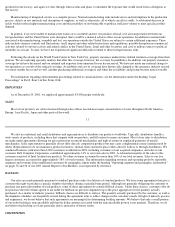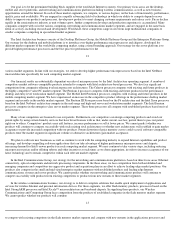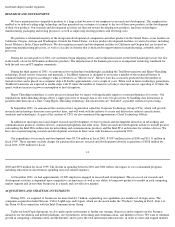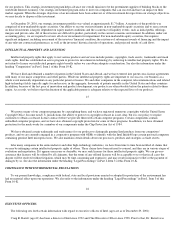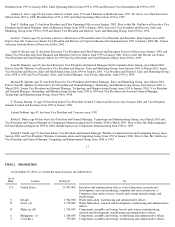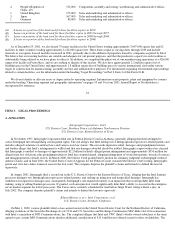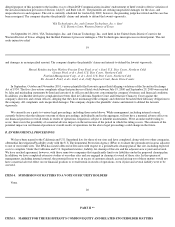Intel 2001 Annual Report Download - page 16
Download and view the complete annual report
Please find page 16 of the 2001 Intel annual report below. You can navigate through the pages in the report by either clicking on the pages listed below, or by using the keyword search tool below to find specific information within the annual report.
(A)
4 People's Republic of
China
(D)
513,000
Components assembly and testing, warehousing and administrative offices.
1
United Kingdom
175,000
Sales and marketing and administrative offices.
3
Japan
167,000
Sales and marketing and administrative offices.
1
Germany
80,000
Sales and marketing and administrative offices.
A lease on a portion of the land used for these facilities expires in 2039.
(B) Leases on portions of the land used for these facilities expire in 2003 through 2057.
(C) Leases on portions of the land used for these facilities expire in 2008 through 2046.
(D) A lease on a portion of the land used for these facilities expires in 2046.
As of December 29, 2001, we also leased 79 major facilities in the United States totaling approximately 3,047,000 square feet and 62
facilities in other countries totaling approximately 2,122,000 square feet. These leases expire at varying dates through 2019 and include
renewals at our option. Leased facilities increased in 2001, primarily due to the addition of properties leased by companies acquired by Intel.
We believe that our existing facilities are suitable and adequate for our present purposes, and that the productive capacity in such facilities is
substantially being utilized or we have plans to utilize it. In addition, we completed the phase-out of our manufacturing operations at a 426,000
square foot facility in Puerto Rico, and we are seeking to dispose of this facility. We also have approximately 2.2 million square feet of
building space in the United States and approximately 1.8 million square feet of building space in various international sites under various
stages of construction for manufacturing, assembly and test and administrative purposes. For information regarding environmental proceedings
related to certain facilities, see the information under the heading "Legal Proceedings" in Part I, Item 3 of this Form 10-K.
We do not identify or allocate assets or depreciation by operating segment. Information on net property, plant and equipment by country
under the heading "Operating segment and geographic information" on pages 35 and 36 of our 2001 Annual Report to Stockholders is
incorporated by reference.
18
ITEM 3. LEGAL PROCEEDINGS
A. LITIGATION
Intergraph Corporation v. Intel
U.S. District Court, Northern District of Alabama, Northeastern Division
U.S. District Court, Eastern District of Texas
In November 1997, Intergraph Corporation filed suit in Federal District Court in Alabama, generally alleging that Intel attempted to
coerce Intergraph into relinquishing certain patent rights. The suit alleges that Intel infringes five Intergraph microprocessor-
related patents and
includes alleged violations of antitrust laws and various state law claims. The suit seeks injunctive relief, damages and prejudgment interest,
and further alleges that Intel's infringement is willful and that any damages awarded should be trebled. Intergraph's expert witness has claimed
that Intergraph is entitled to damages of approximately $2.2 billion for Intel's alleged patent infringement and approximately $350 million for
alleged state law violations, plus prejudgment interest. Intel has counterclaimed, alleging infringement of seven Intel patents, breach of contract
and misappropriation of trade secrets. In March 2000, the District Court granted Intel's motion for summary judgment on Intergraph's federal
antitrust claims, and in June 2001, the United States Court of Appeals for the Federal Circuit sustained the District Court's ruling. Intergraph's
patent and state law claims remain at issue in the trial court. The company disputes the plaintiff's claims and intends to defend the lawsuit
vigorously.
In August 2001, Intergraph filed a second suit in the U.S. District Court for the Eastern District of Texas, alleging that the Intel Itanium
processor infringes two Intergraph microprocessor-related patents, and seeking an injunction and unspecified damages. Intergraph has
withdrawn its request for damages and, consequently, Intergraph's sole requested remedy is an injunction that would prohibit Intel from
making, using or selling Itanium processors. If granted, such an injunction would significantly limit Intel's ability to succeed in the enterprise
server market segment for 64-bit processors. The Texas suit is currently scheduled for trial before Judge Ward, sitting without a jury, in
July 2002. The company disputes plaintiff's claims and intends to defend the lawsuits vigorously.
Edward Harris, et al v. Intel Corporation, et al
U.S. District Court, Northern California
On May 1, 2000, various plaintiffs filed a class-action lawsuit in the United States District Court for the Northern District of California,
alleging violations of the Securities Exchange Act of 1934 and U.S. Securities and Exchange Commission (SEC) Rule 14d-10 in connection
with Intel's acquisition of DSP Communications, Inc. The complaint alleges that Intel and CWC (Intel's wholly owned subsidiary at the time)
agreed to pay certain DSP Communications insiders additional consideration of $15.6 million not offered or paid to other stockholders. The


